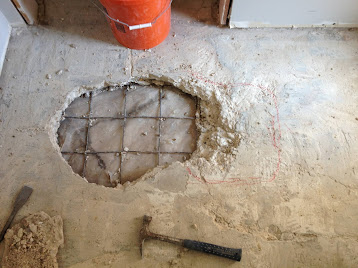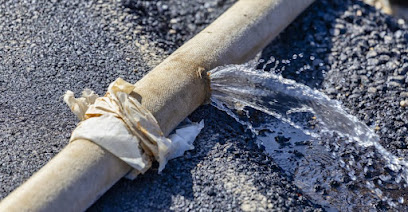How to find & repair slab leaks
1. Check for cracks in the concrete
Cracked concrete is a common issue with many homeowners. Cracks in the exterior of your home can be unsightly, but more importantly can lead to other issues such as water damage and structural problems over time. If you have cracks in the exterior of your home, follow these steps to find out if you should call a professional for help.
1.Look closely at the cracks - Identify if the cracks are straight or curved. If you have a curved crack, this is most likely just normal concrete shrinkage. A professional will not be needed to fix this type of crack.
2.Clear away any dirt and debris from the cracks with your fingers or a soft bristled brush. If there is significant debris in the crack, try and remove as much as possible.
3.Place a small amount of water on the cracked area. If you see it beading up on top of the concrete or running down into the crack, this can indicate that water is entering your home and an issue that should be repaired by a professional.
4.Place a small amount of cooking oil on the cracked area and observe for 5 minutes. If you see the oil beading up, this is likely just normal concrete shrinkage and nothing that needs to be fixed immediately.
5.If you have tried all 3 steps above and still cannot identify if it's safe from damage from exterior cracks, try filling the cracks with a material such as caulk or grout and observe for 24 hours. If this material is displaced from the crack, water may be entering your home and it's time to call a professional plumber.
2. Inspect pipes and plumbing fixtures
Pipes and plumbing fixtures are frequently inspected for cleanliness during the parental inspection of a house or apartment, before new residents move in. It is important to check these components regularly, not only because unclean water can be unsanitary for drinking and other uses, but also because it can ultimately damage pipes and other equipment that is manufactured using materials which react poorly to chemicals and contaminants. It is also important to check pipes frequently while renting, since plumbing fixtures can become clogged for various reasons, including food or other debris getting stuck in them or objects which are flushed down the toilet that don't dissolve properly.
The inspector should document all findings (clean, dirty, broken) and make recommendations for any problems to be fixed. If several fixtures are too dirty, this can suggest that the last tenants were not considerate of other people's health and sanitation (for example, if there was a lot of food stuck in the sink strainer or tub drain).
3. Repair leaks by applying sealant around pipe joints and replacing washers with rubber ones
Just because your home weathers the elements, that does not mean it is impervious to all leaks. Leaks can develop in slab foundations for a variety of reasons. Sometimes slab leaks are caused by pipes that need replacing or joints that require sealing. If you notice water pooling under your house, it's time to assess the situation and take action.
The first step to take when you spot slab leaks is to diagnose the problem and assess what caused it. Most slab leaks are caused by faulty pipes or bad washers. You may find an expert for repairing the slab leak. However, slab leaks can also be caused by larger issues, such as slab uplift . It may be necessary to replace entire sections of slab if the damage has spread too far.
4. Look for water stains on ceilings, walls, or floors
One of the first signs of water damage is water stains. These are typically found on ceilings, walls, or floors. They are usually black, brown, greenish-brown or reddish-brown in appearance and can potentially indicate a variety of different problems.
The first thing you'll want to do when you notice water stains in your home is figure out why they're there in the first place. If you can't figure out why they're there, or if you spot water stains in more than one room of your home, call a professional to investigate.
Conclusion: To find slab leaks, identify any wet spots in your home. If you can't see the leak right away, use a flashlight to look for water stains on ceilings or floors. Check all areas of concern before calling out professionals! We are here to help with professional repairs that will keep your family safe and dry at night when they sleep soundly in their beds. Call us today if you need assistance finding & repairing slab leaks in your home!
Author Bio:- Karl Brown
Karl, a marketing manager at EZ Leak Detection, loves to write about plumbing and HVAC services to make the life of the reader easier. Leakages in your property can be dangerous but not all the leaks are easily accessible. He has given extensive information about water leak and slab leak and tips to detect them quickly along with quick solutions to prevent you from inconveniences and health hazards.
Leakage problems and malfunction of appliances demand comprehensive solutions. Also, regular maintenance is not the thing to be missed for leading life with zero hassles. Read our recent post related to leakage detection and repair, alerts for HVAC shutdown and how to repair it, and installation of AC and water heater in San Diego.





Comments
Post a Comment